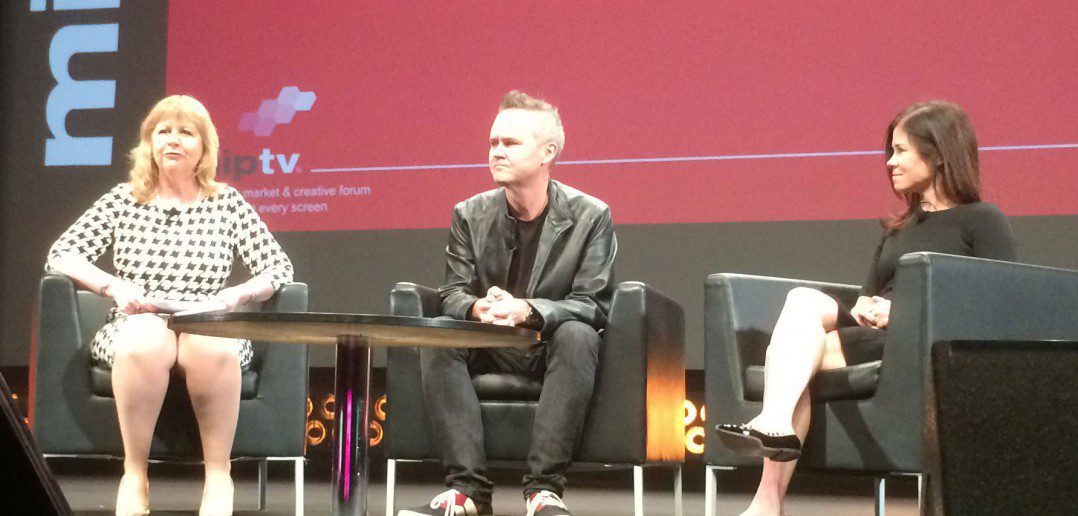It’s an exciting time for TV producers looking for new channels through which to distribute their original content. Netflix, Microsoft (with Xbox) and Amazon are just three of the big technology companies offering new routes to market.
Amazon explained its plans this morning in a MIPTV keynote session from Roy Price, director of Amazon Studios, and Tara Sorensen, head of kids programming at Amazon Studios. The conversation was moderated by media executive Vanessa Chapman, who began by asking why Amazon set up its Studios division.
“Everything we do at Amazon, we let the customers be our guide, and we basically do what customers seem to want and are interested in,” said Price. “We had a subscription video service that people enjoyed, but clearly people are interested in original series, and original ideas and new work, and they really engage with that. So we knew that we should get into that: we should have some of our own signature shows. That’s why we started Amazon Studios.”
Price explained Amazon’s pilots system: it launches pilots of original shows and encourages people to watch, rate and review them, with that data then used by Amazon to decide whether to commission full runs. How do producers feel about this system? “They are thrilled!” he smiled. “I think everybody’s been pretty enthusiastic about the process. There can be some initial trepidation, but at the end of the day we’re in a commercial artform, we’re not exchanging private haikus. It’s going to be out there: you want to get your work out there in front of millions of viewers and see what they think.”
Price showed two clips of new shows: sci-fi drama The After and crime series Bosch, before Chapman asked about rights and budget levels for these kinds of series. “We’re currently in the US, UK and Germany with this subscription service, so outside of those contexts we’re lokoing to distribute to other people,” he said. Sony is distributing
“Our only priority is getting great shows for Amazon customers, so we’re not really religious about exactly what the deal has to look like. There are different flavours, and we can sorta do any of the flavours. Some of them are co-productions, some of them we own entirely. The budgets? They’re premium US cable budgets. If you put them on a list with a bunch of FX, HBO shows, by and large you wouldn’t be able to pick out which were the Amazon shows: it’s that ballpark.”
Price talked about what Amazon looks for in original pilots and shows. “The principle today in an on-demand environment is you really need a group of people who are passionate for a particular show to work,” he said. Shows that have broad but shallow appeal may not work as well.
“You have to find the pocket of people who are really passionate about that show. The best way to get that and to make a real connection and do something really distinctive, is to find a passionate talented creator who has a voice and really wants to do something new: maybe that project they really wrote for themselves because they thought it would be great. I think there’s an opportunity now to do those really distinctive projects.”
Amaozn is currently in production 10 series and 11 pilots. This week, it’s shooting a pilot called Cosmopolitans, as well as another pilot called Hand of God, for example. “You should be able to read the script and say ‘that’s a unique show, you’re not gonna lose sight of it in the clutter’. That’s what we look for,” he said. But then it’s over to the customers with their ratings and reviews.
What’s next? “We are interested in any idea that’s distinctive, and it’s a genre that Amazon customers are responding to,” he said. “Certainly sci-fi, but also Downton Abbey… That gives us a certain amount of latitude. I’d expect to cover all genres and make the decision principle be ‘is it distinctive, is it really great?’.
Over to Sorensen to talk about Amazon’s plans for children’s programming. “A huge part of our customer base is families and kids,” she said. “We decided to start with preschool programming… I knew it was important for us to really think about the shows in a different way.”
She said Amazon has been keen to provide not just great characters, but a strong tie-in to the educational curriculum. “Our educational curriculum is being built out right now,” she continued, outlining Amazon’s view of kids: “The idea that children are natural born explorers and scientists: how can we capture that and then take it through for the rest of their lives?”
Now Amazon is working on shows for 6-11 year-olds, expanding on its previous preschool focus, including some live-action shows. “Kids today are not looking up to the Justin Biebers and Miley Cyruses, they might have different role models, so how can we create at he core smart characters that kids will want to emulate?” she said, before showing some examples of upcoming kids’ shows from Amazon, starting with interactive art series Creative Galaxy, stop-motion series Tumbleaf, and Androids, a live-action show about a girl who’s built three robots to hep her scientific experiments.
All three shows came from established creators, but Amazon is also accepting scripts from up-and-comers: one example being a story about three quirky friends, with a “magical realism aspect to it – you’re not sure if something really happened” according to Sorensen. It’s by a writer who’d never had a commission before, and submitted the script to the Amazon Studios site as his last shot. Now his idea is being made by an Oscar-winning producer.
“We’ve done a really nice job in pairing people together so we’re still speaking to their vision and executing it in a way that they’re proud of, but also surrounding them with showrunners and producers that are experienced,” she said. How are budgets? “Our budgets are also comparable to kids’ networks. We definitely produce in smaller quantities… I think we would certainly look at larger orders if customer feedback supported that,” she said.
What next for Amazon? More pilots coming later this year, but Price said Amazon has just greenlit some shows based on its February pilot season, with some perhaps starting to air by the end of this year.
Price was asked whether Amazon is looking at forging links between its children’s TV activities and the apps that are available for its Kindle Fire tablets: for example, apps based on its original kids’ shows, or which act as interactive companions to them. “We don’t have anything that we can really talk about at this time. It’s clearly an interesting area we’re looking into,” said Price. “We’d like to figure out something along those lines, whether it’s second-screen or the primary thing we should take advantage of. And we’re working out exactly how to do that.”
Price finished off by saying Amazon is open to productions from around the world. “You get something out of shooting in the actual place where the show is set: it just gives you that extra level of reality,” he said. “We’re shooting in Paris for Paris and New York for New York. We’ll go wherever the show takes us.” Sorensen chipped in: “We’re doing productions right now in Canada, we have shows in the UK that are being produced. We really look around the world.”
Be sure to read our exclusive white paper “Building the new digital content market”! Download here (email required)




